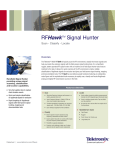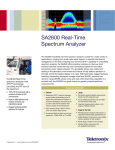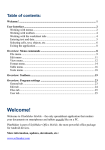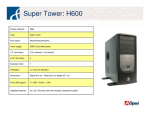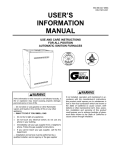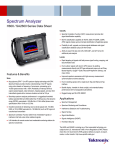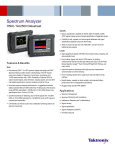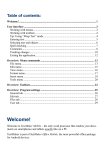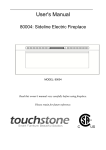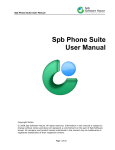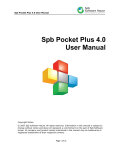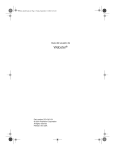Download RFHawkTM Signal Hunter
Transcript
RFHawkTM Signal Hunter Scan - Classify - Locate Overview Handheld Signal Hunter providing unique signal scanning, classification and location capabilities. ■ ■ ■ DPX ™ for live RF view of the spectrum Hawk will quickly scan the RF environment, classify the known signals and The Tektronix® H600 RFH help you locate the unknown signals with its field-proven signal hunting tools. Featuring Real-Time DPX™ capability the RFHawk offers practical solutions for discovering transient events that slip past conventional spectrum analyzers. It is a handheld, rugged, battery operated RF signal hunter with an intuitive set of field signal hunter tools that are matched to the task. It allows for quick scanning of the RF environment, simple, reliable classification of legitimate signals for exclusion and gives you Hawk has surveillance grade field-proven signal hunting, mapping and documentation tools. The RFH hardware featuring an outstanding noise figure and the sophisticated tools necessary to rapidly scan, classify and locate illegitimate analog and digital RF transmission sources in the field. Features & Benefits ■ Quick and simple classification of legitimate signals for exclusion Rapid targeting of illegitimate signals with field-proven signal hunting, mapping and documentation tools Scan ■ Benchtop Spectrum Analyzer performance in a battery-operated field unit ■ Input Frequency Range to 10kHz-6.2GHz to cover most modern signal sources ■ Excellent sensitivity for detecting very low level signals with -153 dBm DANL at 10 Hz RBW ■ ■ Classify ■ Datasheet | www.tektronix.com/rfhawk Revolutionary DPX™ spectrum processing provides intuitive understanding of live RF signals using colors based on frequency of occurrence, displaying 10,000 spectrums per sec with a 100% probability of capturing transients with a minimum duration of 125 microseconds Match signals to known standards using frequency, bandwidth and other criteria ■ Expert-system help with on-screen profile masks for quick frequency offset estimations ■ Flexibility to upgrade databases ■ ■ ■ Examine cyclo-stationary make-up of a given signal to look for specific cyclic components Locate ■ Hunts outdoor signals by plotting measurements directly into GPS-integrated geo-referenced maps ■ Hunts in-building signals with a Tap-and-Walkand-Tap interface ■ No need to return to the office for analysis of dif ficult problems Handheld form factor ■ Field Tested ■ Rugged ■ Touch Screen for intuitive use ■ Long battery life Datasheet | RFHawk Signal Hunter RFHawk: Scan, Classify, Locate Evolving digital wireless communication standards pose an unprecedented challenge to the surveillance and security community. For this community, identification of unknown signals and determining their precise location has traditionally been accomplished using a combination of lab-grade spectrum analyzers, handheld spectrum analyzers, oscilloscopes and off-line analysis capabilities using PCs. When lab equipment is used in the field, several limitations appear. Such instruments are not meant for field use, can be easily damaged, are not portable and require AC power. Signal classification using these systems often requires a lot of prior knowledge about these signals, particularly when they are digital. With such systems the unknown signals can be difficult or impossible to identify. RFHawk Scan By scanning the RF spectrum users can spot which signal emitters are in the area. Signals with significant power are usually candidates for further analysis, as are signals that are present infrequently. By color coding events based on the rate of occurrence, the RFHawk’s DPX™ spectrum display provides unparalleled insight into the behavior of signals. Performing 10,000 spectrum updates per second, transients as brief as 125 µs can be “frozen” in the frequency domain. This offers tremendous improvement over swept analysis techniques. Signals that are present in the spectrum today but were not there yesterday are of particular interest. Reference signals can be stored and deviations from this reference can be quickly identified using the trace math feature. The RFHawk makes analysis easier by quickly logging signals that are weak, bursty, hopping, time multiplexed, or intentionally random. It takes advantage of the FFT-based spectrum analysis capability to allow users to see the true shape of the signal, even when it is bursty. Masks can be automatically created from traces captured earlier. You can compare this mask to the current trace and if a mask violation occurs, the trace is logged. Finally, when the spectrogram is paused, you can scroll through the spectrogram’s time-axis and view the results. 2 Firgure 1. Scan with dedicated monitoring tools Classify Once signals of interest are found, it becomes necessary to identify and classify each of them. Are they authorized, legal signals, or are they illegitimate, malicious signals? Digital signal classification can be a particularly difficult part of the signal hunter’s job requiring extensive knowledge of signal characteristics. The signal may be weak, subject to fading or intermittent conditions. In addition antenna position may be sub-optimal. All of this makes classification of signals more challenging when using traditional signal identification tools. The RFHawk provides advanced algorithms that are capable of classifying signals that cannot be analyzed with other methods. The RFHawk offers unique expert systems guidance to aid the user in classifying signals. It provides graphical tools that allow users to quickly create a spectral region of interest, enabling users to identify and sort signals efficiently. The spectral profile mask, when overlaid on top of a trace, provides signal shape guidance while frequency, bandwidth, channel number, and location are displayed allowing for quick checks. In-depth analysis is provided by a Spectral Correlation Density (SCD) measurement which will spot hidden cyclo-stationary components. SCD provides information on how well the framing, time slot, chip rates and other internal signal rates match the rates of a valid signal. It is faster than manual signal identification techniques, does not require prior knowledge of the signal, and is robust when working with poor signals. SCD tolerates a poor SNR, large carrier frequency offset and fading. Figure 2. Cross match with known standards Figure 3. Low SNR signals reliably classified www.tektronix.com/rfhawk 3 Locate Once the signal has been identified as a threat, the RFHawk provides various field-proven signal-hunting tools to locate the offending signals. For the easier to find signals, the signal strength meter produces tones that vary with pitch as a function of the strength of this signal. This allows the operators to look for signals while watching their surroundings, not the screen. For signals that are harder to find, such as signals influenced by multipath, fading, low signal strength etc, the RFHawk provides several signal mapping tools to facilitate hunting for these signals. Analyzing mapped signals is a quick way to find signals that can be difficult to find otherwise. The mapping capability is also a way to document what you have found. Traces can be recorded on a map either manually or automatically. Built-in GPS can be used to automatically record signal position and time data as the operator moves. For indoor use, a unique tapand-walk interface provides signal mapping capability. Color-coded icons automatically record the relevant measurements based on pre-set thresholds for acceptability. 4 Figure 4. Color-coded measurements for rapid in-field analysis Specifications General Performance Characteristics Characteristic Description RF Input Characteristic 10 kHz – 6.2 GHz Maximum Operating Input Level +20 dBm peak envelope power This is the maximum input level at which the instrument will meet its performance specifications. For a signal without any amplitude variation, peak envelope power = rms. 50 W rms below 3.2 GHz 15 W rms between 3.2 GHz and 6.2 GHz Range Setting Resolution Output Impedance 50 ohms IF Center Frequency 140 MHz IF 3 dB Bandwidth 24 MHz Range Setting Resolution External Reference Input Impedance 1500 ohms Frequency Range 1 MHz up to 20 MHz ± 1 PPM in 1 MHz steps Input Level Range –15 dBm to +15 dBm, 1 MHz to 15 MHz –10 dBm to +15 dBm, 16 MHz to 20 MHz dBm levels assume 50 ohm source 10 Hz to 3 MHz (Manual RBW) 10 Hz to 1 MHz (Auto RBW) 1 Hz Spectral Purity Phase Noise Internal Timebase ± 0.5 PPM from 0 °C to 50 °C ± 1.0 PPM aging/year Twenty minute warm-up period required to meet accuracy specification 10 kHz to 6.2 GHz, preamp off 10 MHz to 6.2 GHz, preamp on 1 Hz Span Displayed Average Noise Level, Preamp On IF Output Error Description Center Frequency Operating Frequency Range Maximum Input Power without Damage Spectrum Analyzer Characteristics Residual Spurious, Preamp Off Residual Spurious, Preamp On Third Order IMD Second Harmonic Input Related Spurious Input Related Spurious, exception frequencies, typical Third Order Intercept –153 dBm, 10 MHz to 2 GHz, 10 Hz RBW –152 dBm, 2 GHz to 4 GHz, 10 Hz RBW –151 dBm, 4 to 5 GHz, 10 Hz RBW –145 dBm, 5 to 6.2 GHz, 10 Hz RBW Reference Level (DANL + 90 dB) ≤ -95 dBc/Hz @ 10 kHz offset ≤ –95 dBc/Hz @ 20 kHz offset ≤ –95 dBc/Hz @ 30 kHz offset ≤ –97 dBc/Hz @ 100 kHz offset ≤ –110 dBc/Hz @ 1 MHz offset ≤ –90 dBm, 0 dBm attenuator setting Exception frequencies: 9 MHz to 19 MHz center frequency 3464 MHz center frequency 4592 MHz center frequency 5374 MHz to 5378 MHz center frequency 6160 MHz center frequency ≤ –105 dBm, 0 dBm attenuator setting Exception frequencies: 9 MHz to 19 MHz center frequency 5374 MHz to 5378 MHz center frequency ≤ –70 dBc for two tones at or below the reference level, preamp off, all gain settings Auto-coupled ≤ –60 dBc for a single tone at or below the reference level, preamp off, all gain settings Auto-coupled ≤ –70 dBc Fin= 2.282 GHz ± 20 MHz The reference for 'dBc' for this specification is the total power of all signals present at the input of the instrument regardless of the current span ≤ –55 dBc Fin= 2.282 GHz ± 20 MHz The reference for “dBc” for this specification is the total power of all signals present at the input of the instrument regardless of the current span ≥ +7 dBm, 0 dB Input Attenuation, Preamp Off www.tektronix.com/rfhawk 5 Spectral Display Amplitude Reference Level Range Marker Power Accuracy General Purpose RF Measurements Characteristics +20 dBm to –160 dBm Characteristic Description ±1.75 dB, –50 dBm ≤ input ≤ +20 dBm, preamp off ±3.0 dB, –80 dBm ≤ input < –50 dBm, preamp on, above 10 MHz ±3.75 dB, –120 dBm ≤ input < –80 dBm, preamp on, above 10 MHz Use peak detector for CW-like signals; use average detector for wideband (signal >> RBW) Accuracy guaranteed for CW signals and span set to 20 MHz or less General Purpose RF Channel Power Measurement Display Accuracy Normal - updates display with each new result Max Hold - updates displayed point only if new point > old Min Hold - updates displayed point only if new point < old Max/Min Hold - displays a vertical bar between Max Hold and Min Hold Average - displays average of N (specified by user) acquisitions Display Modes Average is calculated as follows: Last N values are saved in memory; when a new result is available, the earliest result of the N stored values is discarded, the new result is added to the stored values, and a new average is calculated from the stored values If the number of results is less than N, then all of the results are averaged together Number of Averages Measurement Bandwidth Range 1 ≤ N ≤ 200 1 kHz - 20 MHz ≤ 1.2 dB; +20 dBm to –60 dBm; Resolution BW < 100 kHz +20 dBm to –40 dBm; Resolution BW ≥ 100 kHz 1 MHz to 3.2 GHz , preamp off ≤ 2 .4 dB; –60 dBm to –75 dBm; Resolution BW < 100 kHz –40 dBm to –55 dBm; Resolution BW ≥ 100 kHz 10 MHz to 3.2 GHz , preamp on ≤ 1.8 dB; +20 dBm to –50 dBm; Resolution BW < 100 kHz +20 dBm to –40 dBm; Resolution BW ≥ 100 kHz 3.2 GHz to 6.2 GHz , preamp off ≤ 3 dB; –50 dBm to –75 dBm; Resolution BW < 100 kHz –40 dBm to –55 dBm; Resolution BW ≥ 100 kHz 3.2 GHz to 6.2 GHz , preamp on Specifications apply for default control settings (Auto RBW, Auto Level) Occupied Bandwidth Measurement Percent Power Inclusion Range 50% - 100% RF Field Strength Channel Same as Channel Power Bandwidth Range Accuracy Same as Channel Power DPX™ Measurements Processing Characteristics Characteristic Description Spectrum Processing Rate, nominal 10,00 per second (span independent) Min Signal Duration for 100% Probability 125 µs of Intercept, typical Span Range Mapping Native Map Type Graticule (.gsf) Map types directly supported MapInfo (*.mif) Bitmap (*.bmp) Other Map types accepted using PC application iMap Converter MapInfo (*.mif) Bitmap (*.bmp) Other raster formats (*.gif, *.jpg, *.png, *.tif) Google Earth Microsoft MapPoint USGS DLG (*.opt) ESRI ArcInfo Shape (*.shp) 20 kHz to 20 MHz Battery Life 5 hours of continuous Spectrum Mode (with optional second battery). Actual life can be higher depending on usage. 6 Physical characteristics Signal Analysis and Monitoring Characteristics Characteristic Description Characteristic Description AM Demodulation Provides an audio output signal after AM demodulation of the user-selected signal Dimensions Height: 25.5 cm. (10.0 in) Width: 33 cm. (13 in) Depth: 12.5 cm. (4.8 in) Weight 5.56 kg (12.27 lbs) Measurement Frequency As previously selected Minimum Input Signal Level, Typical -100 dBm Audio Measurement Bandwidth 8 kHz Provides an audio output signal after FM demodulation of the user-selected signal FM Demodulation Measurement Frequency As previously selected Minimum Signal Level, Typical -100 dBm Maximum Signal Deviation Up to 100 kHz Audio Measurement Bandwidth 8 kHz, 15 kHz, 75 kHz, or 200 kHz Maximum Audio Output Bandwidth 15 kHz Provides both an audio tone and a visual display that are related to the strength of the user selected signal Signal Strength Indicator Input Signal Level -120 dBm, minimum Measurement Frequency As previously selected Measurement Bandwidth Up to 20 MHz, dependent upon span and RBW setting Tone Type Variable beep rate or variable frequency Update Rate, Typical 10 per second Display characteristics Characteristic Description Color Display 10.4 in. (diagonal), transflective LCD Resolution: 640x480 (VGA) Miscellaneous characteristics Characteristic Description Recommended Instrument Calibration Interval 2 years Safety compliance Characteristic ANSI/UL61010-1:2004 Electrical Equipment for Measurement, Control, and Laboratory Use. Environmental characteristics Characteristic Description Temperature Operating: 0 °C to +50 °C specified performance, –10 °C to +50 °C, typical Nonoperating: –40 °C to +60 °C The temperature specs above are modified with the following options installed: Li-Ion Batteries: Charge 0 °C to +45 °C, Storage –20 °C to +60 °C Humidity Operating and Nonoperating: 5% to 95% relative humidity (RH) at up to +30 °C, 5% to 45% RH above +30 °C up to +50 °C, noncondensing Altitude Operating: Up to 4,600 meters (15,092 feet) Nonoperating: Up to 12,192 meters (40,000 feet) Description CSA C22.2 No. 61010.1:2004 Electrical Equipment for Measurement, Control, and Laboratory Use. Safety Compliance EN 61010-1:2001 Electrical Equipment for Measurement, Control, and Laboratory Use. IEC61010-1:2001 Electrical Equipment for Measurement, Control, and Laboratory Use. ISA 82.02.01 Electrical Equipment for Measurement, Control, and Laboratory Use. www.tektronix.com/rfhawk 7 Datasheet | RFHawk Signal Hunter About Tektronix: Ordering Information H600 RFHawk Signal Hunter with built-in GPS (includes GPS antenna) Warranty ■ Service Options ■ One Year on parts and labor ■ ■ Language Options ■ H600 L0 ■ English manual ■ ■ ■ Standard Accessories ■ ■ ■ ■ ■ ■ ■ ■ ■ ■ H600 RFHawk Quick Start User Manual H600 RFHawk installation software AC Power Adapter Lithium-Ion Battery GPS Antenna Tilt stand Soft carry case BNC Connector cover (2) N Connector cover (1) Audio jack mute plug (mute all audio output from the instrument speaker) ■ H600 R3 H600 R5 H600 C3 H600 C5 H600 CA1 H600 D1 H600 D3 H600 D5 Repair Service 3 Years (including warranty) Repair Service 5 Years (including warranty) Calibration Service 3 Years Calibration Service 5 Years Provides a single calibration event or coverage Calibration Data Report Calibration Data Report 3 Years (with Option C3) Calibration Data Report 5 Years (with Option C5) Tektronix has more than 60 years of experience in providing network operators and equipment manufacturers a comprehensive and unparalleled suite of network diagnostics and management solutions for fixed, mobile, IP and converged multi-service networks. These solutions support such architectures and applications as fixed mobile convergence, IMS, broadband wireless access, WiMAX, VoIP and triple play, including IPTV. Power Options ■ ■ ■ ■ ■ ■ ■ ■ ■ ■ H600 L99 H600 A0 H600 A1 H600 A10 H600 A11 H600 A2 H600 A3 H600 A5 H600 A6 H600 A99 No Manual Power Options North America Universal EURO China India United Kingdom Australia Switzerland Japan No Power Cord or AC Adapter For Further Information: Tektronix maintains a comprehensive, constantly expanding collection of application notes, technical briefs and other resources to help engineers working on the cutting edge of technology. Please visit www.tektronix.com/communications Suggested RFHawk Accessories ■ Antenna Beam Antenna, 824 to 896 MHz: Order 119-6594-00 Beam Antenna, 896 to 960 MHz: Order 119-6595-00 Beam Antenna, 1710 to 1880 MHz: Order 119-6596-00 Beam Antenna, 1850 to 1990 MHz: Order 119-6597-00 Magnetic Mount Antenna, 824 to 2170 MHz: Order 119-6970-00 (needs adapter 103-0449-00) ■ Filters Pre-Filter, General Purpose, 824 to 2500 MHz, Type-N (f) Connector – Order 119-7246-00 Pre-Filter, General Purpose, 824 to 6200 MHz, Type-N (f) Connector – Order 119-7426-00 ■ Cables ■ Misc Cable, 50 Ω , BNC (m) 3 foot (91 cm): Order 012-0482-00 Cable, 50 Ω , Straight Type-N (m) and angled Type-N (m) connector, 1.6 foot (50 cm): Order 174-4977-00 Cable, 50 Ω , Type-N (m) to Type-N (m) connector, 3 foot (91 cm): Order 174-5002-00 External Charger: order 119-6030-00 AC Power Supply: order 119-6984-00 DC Vehicle Adapter: order 119-6028-00 Lithium-Ion Battery: order 146-0151-01 Display Protector Sheets (5): order 016-1882-00 Copyright © Tektronix. All rights reserved. Tektronix products are covered by U.S. and foreign patents, issued and pending. Information in this publication supersedes that in all previously published material. Specification and price change privileges reserved. TEKTRONIX and TEK are registered trademarks of Tektronix, Inc. All other trade names referenced are the service marks, trademarks or registered trademarks of their respective companies. 06/08 | CWW-21699-2 (DND) Contact Tektronix: Please visit www.tektronix.com/communications Phone: 1-800-833-9200 option 1 +1-469-330-4000 Locate your nearest Tektronix representative at: www.tektronix.com/contactus








